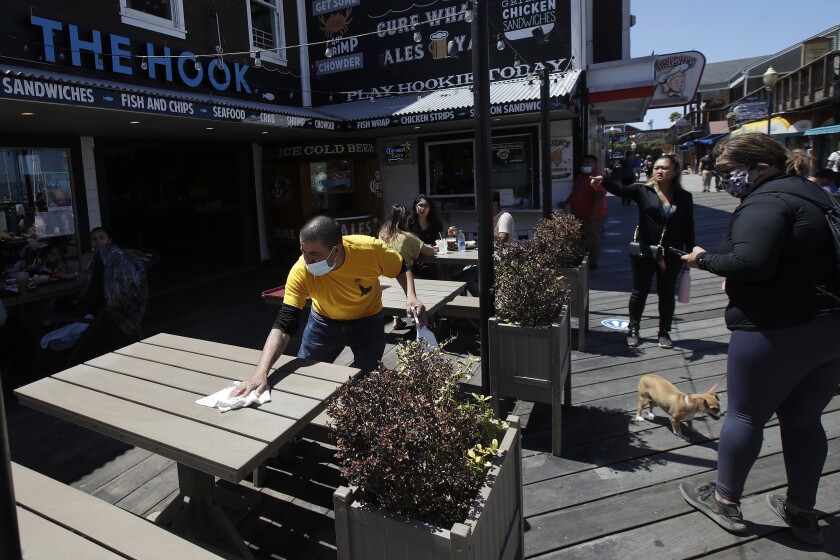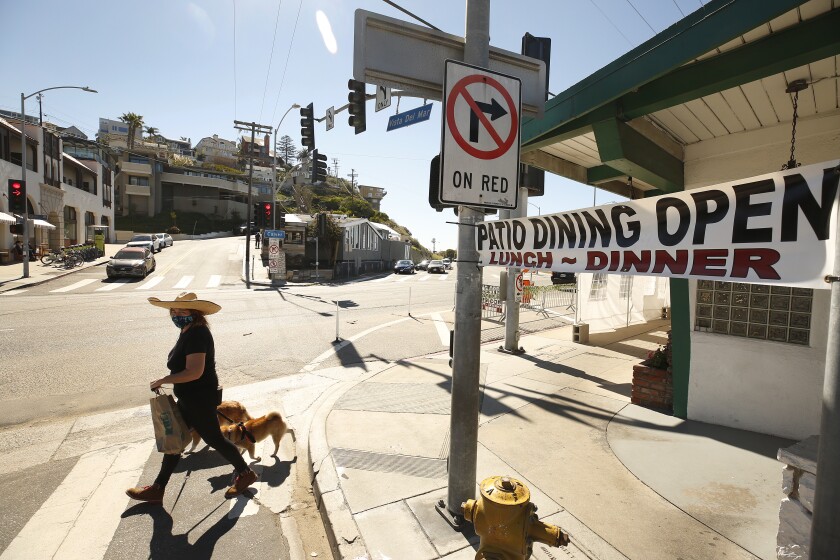
With COVID-19 cases on the decline, Los Angeles and Orange counties are inching closer to being able to significantly reopen their economies.
Both heavily populated counties are now on the cusp of potentially moving into the red tier, a more permissive category of the state’s reopening road map that would allow wider indoor business operations — including at restaurants and gyms — as well as the resumption of in-person classes for students in grades 7 through 12.
The earliest either county could advance is two weeks from now, and they’ll only do so if select measures of coronavirus transmission hit certain state-set benchmarks.
But officials in both counties said they believe progress is on the horizon.
“I’m pretty optimistic that, two weeks from now, we’ll be able to enter the red tier,” Dr. Clayton Chau, director of the OC Health Care Agency and health officer for the county, said during a briefing Tuesday.
Officials with the L.A. County Department of Public Health told The Times on Tuesday that they are similarly hopeful.
But officials are also urging caution, saying conditions could still deteriorate if residents and businesses aren’t careful. The fall and winter coronavirus wave hammered Southern California, and the region has, to this point, been slower to reopen than other areas of the state.
Reopening basics
In California’s coronavirus reopening blueprint, each county is assigned to one of four color-coded tiers — ranging from the strictest, purple, to red, then orange and, finally yellow, the most permissive.
Tier assignments are based on three criteria: average daily case rates, adjusted based on the number of tests performed; the testing positivity rate; and a health equity metric intended to ensure that the positivity rate in poorer communities is not significantly worse than the county’s overall figure.
Counties must meet the next tier’s criteria for two weeks in order to advance to it.
Within each tier is a set of restrictions that counties must follow. In the purple tier, for instance, many businesses and public facilities have to suspend or severely limit indoor operations.
L.A. County, long the epicenter of California’s coronavirus outbreak, now meets two of the three criteria necessary to progress to the red tier. The case rate is what’s holding the region back.
To move ahead, L.A. County needs that number to be no higher than 7.0 new cases per day per 100,000 people. On Tuesday, it was 7.2, according to the latest state data. Last week, it was 12.3; the week before that, it was 20.
The case rate for Orange County was most recently calculated at 7.6. Last week it was 11.9, down from 20.7 the week before.
Orange County has reached the red tier before, but was thrust back into purple in mid-November, when state officials dramatically rolled back reopening in much of the state as coronavirus infections began to spike.
L.A. County, on the other hand, has never moved out of the purple tier. The color-coded system was unveiled in late August.
“Since there is still widespread transmission occurring in our county, we are hoping we do not see increases in the number of daily cases in the upcoming weeks that will pause our recovery journey and cause more hospitalizations,” county Public Health Director Barbara Ferrer said in a statement. “With an increase in the circulation of variants, we need to ask our residents, workers and businesses to continue following the safety measures…. including wearing a mask and physically distancing from others not in your household to prevent spread.”
Counties in the red tier can allow indoor restaurant dining and movie theaters to reopen at 25% capacity or up to 100 people, whichever is fewer. Indoor gyms and dance and yoga studios can open at 10% capacity. Museums, zoos and aquariums can open indoor activities at 25% capacity, and nonessential stores and libraries can open at 50% capacity, up from 25% capacity.
The red tier, however, still keeps a number of venues closed — including amusement parks and convention centers; bars, breweries and distilleries where no meals are provided; indoor swimming pools; indoor entertainment areas such as bowling alleys, escape rooms and laser tag facilities; and indoor card rooms. Watching outdoor professional sports in person is still prohibited in the red tier.
Counties can unlock such activities, though largely still in a modified fashion, when they move into the orange and yellow tiers.
All the tier rules serve as a baseline for local health agencies, which can adopt even stricter regulations if they feel it’s necessary, though they cannot be more lenient.
City News Service contributed to this report.
Source: Los Angeles Times


